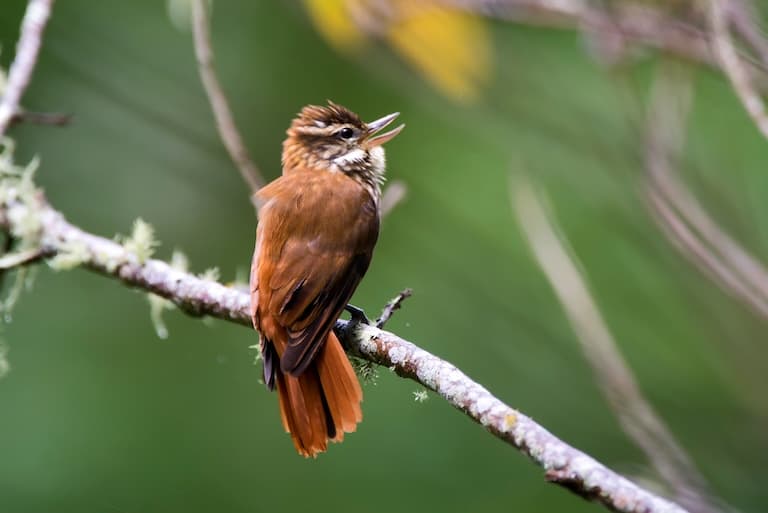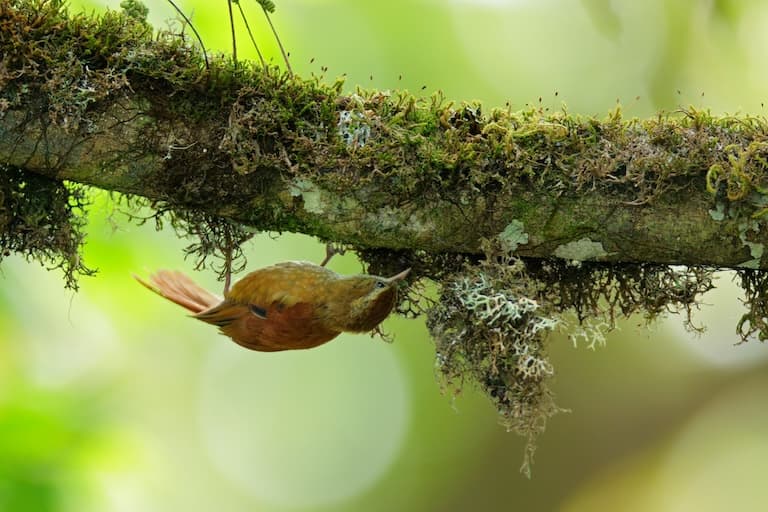Xenops Profile
In a traditional and somewhat morbid 17th Century British rhyme, a clumsy maid baked the wrong birds into a pie and they all escaped and then pecked off her nose.
Unfortunately for the maid, the far more bakeable “ovenbirds” would have been hard to come by, even for the monarchy at the time, as they’re a tropical family from the New World.
Xenops is one such ovenbird genus, and a small but mighty representative of a diverse family.

Xenops Facts Overview
| Habitat: | Wet forests and foothills with trees |
| Location: | Mexico, Central and South America |
| Lifespan: | 10 years or more |
| Size: | Around 12 cm long (4.7 in) |
| Weight: | Up to about 13 g (0.46 oz) |
| Colour: | Varied, but mostly. Tawny or brown, all but one are streaked on the head |
| Diet: | Insectivores; almost entirely arthropods |
| Predators: | Not clear |
| Top Speed: | Not recorded |
| No. of Species: | 5 |
| Conservation Status: | All of Least Concern |
Being tiny, rather average-looking songbirds in South America, the Xenops genus isn’t one of the best studied at all, and there’s a lot of information missing from their profiles.
One thing that’s certain, though, is that they have one of the most sci-fi names in the animal kingdom. These unassuming little insectivores get by with special, upturned beaks that allow for a range of foraging strategies, and their fast reproduction and fearlessness have maintained their populations fairly well in the face of habitat destruction.
Interesting Xenops Facts
1. The Great Xenops
The oven birds, as a concept, are a confusing lot. First, there is the ovenbird itself, Seiurus aurocapilla, which ironically isn’t in the ovenbird family at all. This species overwinters in Central America, which is also where the furnariids also spend most of their time.
The Furnariids are the overnbirds, and they contain over 300 species of small songbirds in 71 genera.
But it doesn’t end there. Of these 71 genera, only the genus Furnarius appears to actually make the oven-like, mud nest that gave the family their name. Xenops is one of the 98.6% of the ovenbird genera that don’t make ovens at all.
And yet there is one more degree of convolution to consider. The bird with perhaps the best name of any animal, the Great Xenops, isn’t a Xenops at all, but a member of the Power-Ranger-esque Megaxenops, which is presumably the genus you have to fight when you piss off the five Xenops species and they combine to kick your ass.
Those five species are: the White-throated Xenops; the Slender-billed Xenops; the Rufous-tailed Xenops; the Plain Xenops; and the Streaked Xenops (played by Billy Cranston, Trini Kwan, Jason Lee Scott, Kimberly Hart, and Zack Taylor, respectively).

2. They’re woodpeckerish
These little birds are all insectivores, and they acquire their food in a range of ways. It seems as though most species forage mainly from the understory, sometimes with friends from other species. But they’ll also peck and scrape at the bark of tree branches to find their lunch, using special beaks to flip over, chisel out, or carve into pieces of bark, and they have specialised, upturned beaks precisely for this reason.
This is one of the easiest ways to recognise them, and while they aren’t as hardcore as the much larger, headbanging woodpeckers, they do sometimes reach the upper canopy when foraging, and they’ll excavate holes in rotten wood to nest in. They can also sometimes use woodpecker holes as nests. 1

3. They make regular nests
Despite being tarred with the ovenbird name, these are not the mud dome builders that the family is named for. The Xenops nest is the pretty standard twig and fluff architecture of the average songbird, but for the fact that they’ll hide it inside a hole in a log.
4. They can reproduce fairly fast
Inside these very regular nests, the Xenops can lay up to five eggs, but it’s much more common that there are around two per clutch.
These eggs are only incubated for two weeks before they hatch, and fledging is just a matter of two more weeks after that. So, they pop out generations pretty quickly, and being a tropical species, they get two seasons per year to do it in. Both males and females take equal responsibility for incubation, feeding and fledging2.
This makes them quite quick to multiply, and so they’re fairly confident little animals, even when humans are around.
5. They’re all doing fine
These small birds seem quite tolerant of human presence, for the most part. They don’t seem to be very skittish, and will happily complete a breeding cycle even in the presence of human development.
This boldness has likely helped out the five species a lot, as their habitats are in decline, and three of the five species are estimated to be decreasing in populations, but as of the most recent assessments, all are of least concern, and two species have a stable population to boot!3

Xenops Fact-File Summary
Scientific Classification
| Kingdom: | Animalia |
| Phylum: | Chordata |
| Class: | Aves |
| Order: | Passeriniformes |
| Family: | Furnariidae |
| Genus: | Xenops |
| Species Name: | 5 Species |
Fact Sources & References
- Decker et al, (2024), “Northern Plain-Xenops”, Cornel Lab.
- (2025), “Streaked Xenops”, BirdForum.
- “Xenops”, IUCN Redlist.
